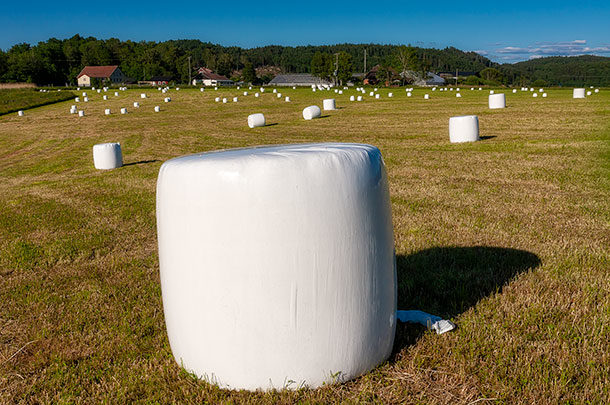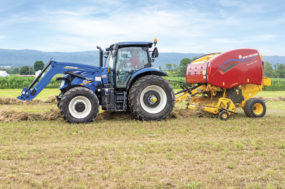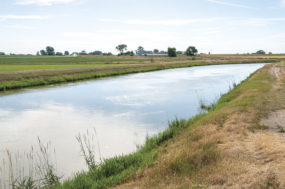One way to maintain forage quality with small, dry weather windows is to make silage or baleage instead of dry hay. The ideal conditions for baleage is to bale the hay between 40% and 65% moisture and wrap within two hours of baling. This process uses anaerobic conditions, and the acids produced in fermentations preserve hay. Baleage fermentation is slower than in haylage, often taking six weeks. When forage is baled between 25% to 40% moisture, it will not ferment properly, and baleage at these moisture levels should be considered as temporary storage. During such situations, preservation is primarily a function of maintaining anaerobic, oxygen-limiting conditions. Mold is very likely at this moisture; higher bale densities and more wraps of plastic is required to better seal out oxygen. Baleage at this moisture will not maintain quality very long in storage, and thus, it needs to be fed as soon as possible. Baleage can be utilized as a plan or as a backup, but the best baleage is a plan and not a rescue.
If you are thinking baleage might be a needed option for you, either as planned or when your dry hay window disappears, start your plan before you are calling around to find a bale wrapper. The first consideration is how fast will you be able to feed the forage? This is a major consideration when selecting the type of bale wrapper you will buy or rent. The two options are individual wrappers, which are usually ideal if feeding 50 head or less from these bales.
These machines can usually wrap 20 to 30 bales per hour and use twice as much plastic as a line wrapper. Line wrappers can wrap 40 to 50 bales per hour using less plastic, but they require uniformity between bales. When bales aren’t uniform, there is oxygen captured between bales, often leading to spoilage within the tube of bales where bales meet. They require higher feedout rates of ideally two bales per day. With a line wrapper, the end of the next bale is exposed to oxygen when you remove one bale to feed, and the spoilage clock begins.
Determining where you will be storing bales ahead of time is very important. Making sure the plastic is not punctured, allowing oxygen to enter and spoil the forage due to storage site selection, is critical. Ideal storage is in a well-drained location with year-round access. Stone pads can work well as long as they don’t puncture the plastic. Be wary of storing on stubble, grassy areas or under trees. These areas often attract rodents, lead to plastic damage, or have sticks that fall and puncture the plastic. Stored forage should be checked weekly for damage and holes taped as soon as they are found.
While keeping oxygen out is the most important part of making high-quality baleage, it starts with mowing. When baleage is the planned storage method, your harvest capacity-limiting factor will be how many bales you can wrap an hour, with the ideal goal of wrapping the bales within four hours. Based on research done at University of Wisconsin – Madison, we recommend laying swaths as wide as your mower will allow, helping preserve forage quality and speeding up drying to 65% moisture by 10.8 hours. When baling, your goal needs to be for the highest density bales that you can make.
A study from Penn State shows that by increasing bale density from 6 pounds per cubic foot to 8 pounds per cubic foot, you gain an extra 12 hours of bunk life in the haylage, due mostly to better bale fermentation. It is important to wrap bales as soon as possible after baling to avoid spoilage. The temperatures of bales that were wrapped each day from at baling to four days after baling are provided in Figure 1 (data from University of Wisconsin), with the temperature on day one representing the actual day of wrapping. This data shows that just 24 hours after baling, the bales that are not wrapped were over 120ºF. While wrapping bales even four days after baling stopped the heating process, the quality of these bales still declined.
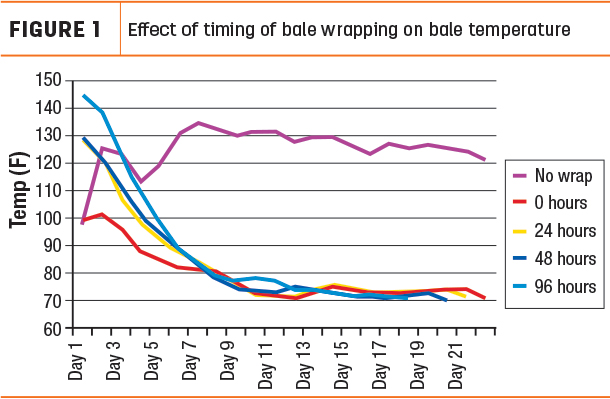
Most bale wrap is 1 millimeter low-density polyethylene, and bales need a minimum of 5 millimeters of plastic to seal out oxygen, requiring a minimum of six wraps. Types of plastic vary greatly in their stretchiness, which can reduce thickness by up to 25%. Some stretch is necessary so that the plastic stays sticky and seals well between the layers of plastic. Be cautious when wrapping in the rain as this will reduce the stickiness and allow more oxygen to penetrate, causing spoilage. Also, be cautious when wrapping forages that poke through the plastic, which will require more layers.
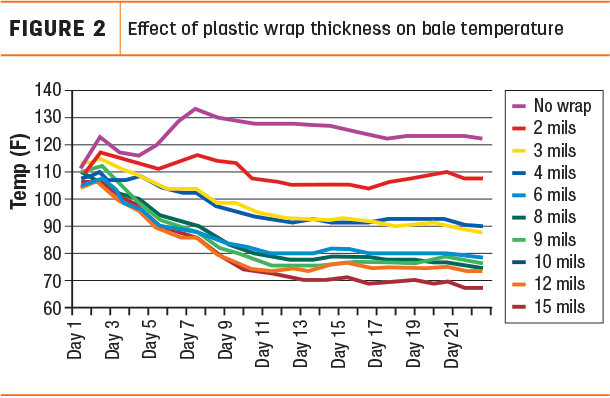
When oxygen enters the bales, they start to heat, and quality declines when temperatures are over 120ºF. The amount of time until bales are wrapped and the number of millimeters of wrap significantly affects internal bale temperature. Figure 2 shows that 6 to 12 millimeters of plastic maintained similar bale quality. With less wraps than this, bale spoilage is often prevalent. The general recommendations for layers of bale wrap are provided in Table 1.
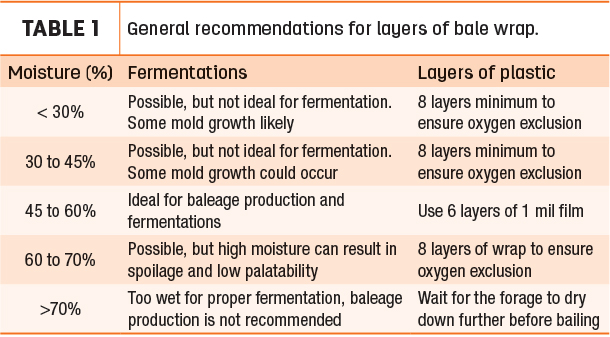
After bales are wrapped, handle them carefully using a squeeze so that plastic is not torn. If plastic is torn in storage, the tears should be taped as soon as you notice them. For this reason, bales should be inspected weekly in storage. Never use bale spears to move wrapped haylage until the day you are going to feed it. It is recommended that bales be fed within a year of wrapping. Haylage that is too wet, over 60% moisture, should be fed within three months, and haylage that is below 40% will not ferment well and should be fed within six months.
Most of the time, when we make baleage as a rescue, it falls in the range of needing to be fed within six months. When done right, baleage can last a year and make excellent feed that often has 5% better quality than dry hay. When done wrong, haylage can spoil, mold and grow organisms that will make your animals sick; use your eyes and nose to be sure the forage you’re going to feed is of high quality. Don’t force animals to eat forage they don’t want. ![]()
Reference omitted but are available upon request. Click here to email an editor.
Jason Hartschuh is an extension educator for agriculture and natural resources, Crawford County, Ohio State University Extension.
PHOTO: Getty Images.
—Excerpts from Ohio State University Extension Buckeye Dairy News, Volume 21, Issue 3
